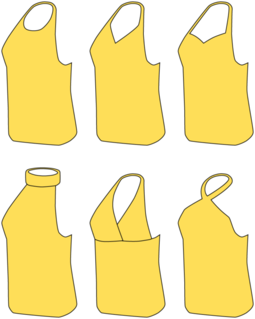 W
WThe neckline is the top edge of a garment that surrounds the neck, especially from the front view. Neckline also refers to the overall line between all the layers of clothing and the neck and shoulders of a person, ignoring the unseen undergarments.
 W
WA boat neck, also called a bateau neck or Sabrina neckline, is a wide neckline that runs horizontally, front and back, almost to the shoulder points, across the collarbone. It is traditionally used in nautically inspired sweaters and knitwear, but is also featured in more elegant cocktail dresses and eveningwear. The style derives from sailors' blouses or sweaters, often with wide navy and white horizontal stripes.
 W
WCleavage is the narrow depression or hollow between human breasts. The superior portion of cleavage may be accentuated by clothing such as a low-cut neckline that exposes the division. Joseph Breen, head of the U.S. film industry's Production Code Administration, coined the term in its current meaning when evaluating the 1943 film The Outlaw, starring Jane Russell. The term was explained in Time magazine on August 5, 1946. It is most commonly used in the parlance of Western female fashion to refer to necklines that reveal or emphasize décolletage.
 W
WA clerical collar, clergy collar, Roman collar or, informally, dog collar is an item of Christian clerical clothing. The collar closes at the back of the neck, presenting a seamless front. The shirt may have the collar built in. The clerical collar is almost always white and was originally made of cotton or linen but is now frequently made of plastic. Sometimes it is attached with a collaret or collarino that covers the white collar almost completely, except for a small white square at the base of the throat, and sometimes with the top edge of the collar exposed to mimic the collar of a cassock. It may simply be a detachable tab of white in the front of the clerical shirt. The clerical shirt is traditionally black, but today is available in a variety of colors depending on the wearer's preference. Once the clerical collar is removed the garment is indistinguishable from any other shirt. When clergy are delivering sermons, they sometimes attach preaching bands to their clerical collar.
 W
WIn clothing, a collar is the part of a shirt, dress, coat or blouse that fastens around or frames the neck. Among clothing construction professionals, a collar is differentiated from other necklines such as revers and lapels, by being made from a separate piece of fabric, rather than a folded or cut part of the same piece of fabric used for the main body of the garment.
 W
WA crew neck is a type of shirt or sweater that has a round neckline and no collar, often worn with other layers. The name dates back to 1939 and was named after a type of sweater worn by rowers.
 W
WA grandfather shirt or grandad shirt or "50s T-Shirt" is a long-sleeved or short-sleeved flannel or brushed cotton band collared shirt worn throughout Ireland. Traditional shirts are white with coloured vertical stripes. Longer shirts are used as nightshirts or pajamas. The nightshirt version can include a matching nightcap.
 W
WHalterneck is a style of women's clothing strap that runs from the front of the garment around the back of the neck, generally leaving the upper back uncovered. The name comes from livestock halters. The word "halter" derives from the Germanic words meaning "that by which anything is held". Halter is in the German word Büstenhalter, a dated word for bra, with Büste meaning female chest and breasts.
 W
WA mandarin collar, standing collar, band collar or choker collar is a short unfolded stand-up collar style on a shirt or jacket. The style derives its Western name from the mandarin bureaucrats in Qing-era China that employed it as part of their uniform.
 W
WA polo neck, roll-neck (UK), turtleneck, or skivvy is a garment—usually a sweater—with a close-fitting collar that folds over and covers the neck. It can also refer to the type of neckline, the style of collar itself, or be used as an adjective.
 W
WA scoop neck shirt is one in which the scoop-shape neckline drops significantly below normal limits. Some scoop neck shirts, when worn by women, are cut low enough to display significant amounts of cleavage. These shirts come in a variety of forms, including those with and without buttons. At least one fashion designer has recently produced a line of shirts for men that can be converted to scoop neck shirts by clipping a thread in the collar. The scoop neck shirt is often worn as sports or casual wear by women, and has grown increasingly fashionable for men.